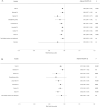Association of SARS-CoV-2 infection with physical activity domains and types
- PMID: 37932323
- PMCID: PMC10628273
- DOI: 10.1038/s41598-023-46162-4
Association of SARS-CoV-2 infection with physical activity domains and types
Abstract
Lockdown imposed in the early phase of the SARS-CoV-2 outbreak represented a specific setting where activity was restricted but still possible. The aim was to investigate the cross-sectional associations between physical activity (PA) and SARS-CoV-2 infection in a French population-based cohort. Participants completed a PA questionnaire. PA was classified into: (i) total PA; (ii) aerobic PA by intensity; (iii) strengthening PA; (iv) PA by domain and type; and (vii) by location. Sedentary time was also recorded. Seroprevalence of anti-SARS-CoV-2 antibodies was assessed. Multivariable logistic regression models controlling for sociodemographic, lifestyle, anthropometric data, health status, and adherence to recommended protective anti-SARS-CoV-2 behaviours were computed. From 22,165 participants included, 21,074 (95.1%) and 1091 (4.9%) had a negative and positive ELISA-S test result, respectively. Total PA, vigorous PA, leisure-time PA, household PA, outdoor PA and indoor PA were all associated with lower probability of SARS-CoV-2 infection. Observations made in such a setting shed light on PA possibilities in a context of restricted mobility, where the health benefits of PA should not be overlooked. Along with already well-established benefits of PA for non-communicable disease prevention, these findings provide additional evidence for policies promoting all types of PA as a lever for population health.
© 2023. The Author(s).
Conflict of interest statement
Prof. Fabrice Carrat reports personal fees from Imaxio and Sanofi, outside the submitted work. All other authors declare no competing interest.
Figures


References
Publication types
MeSH terms
LinkOut - more resources
Full Text Sources
Medical
Miscellaneous

